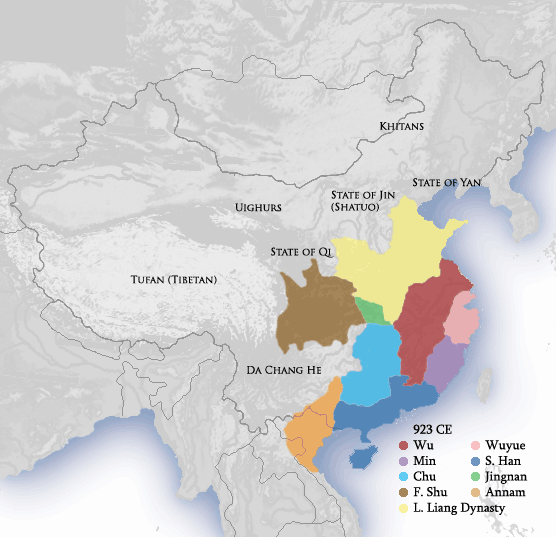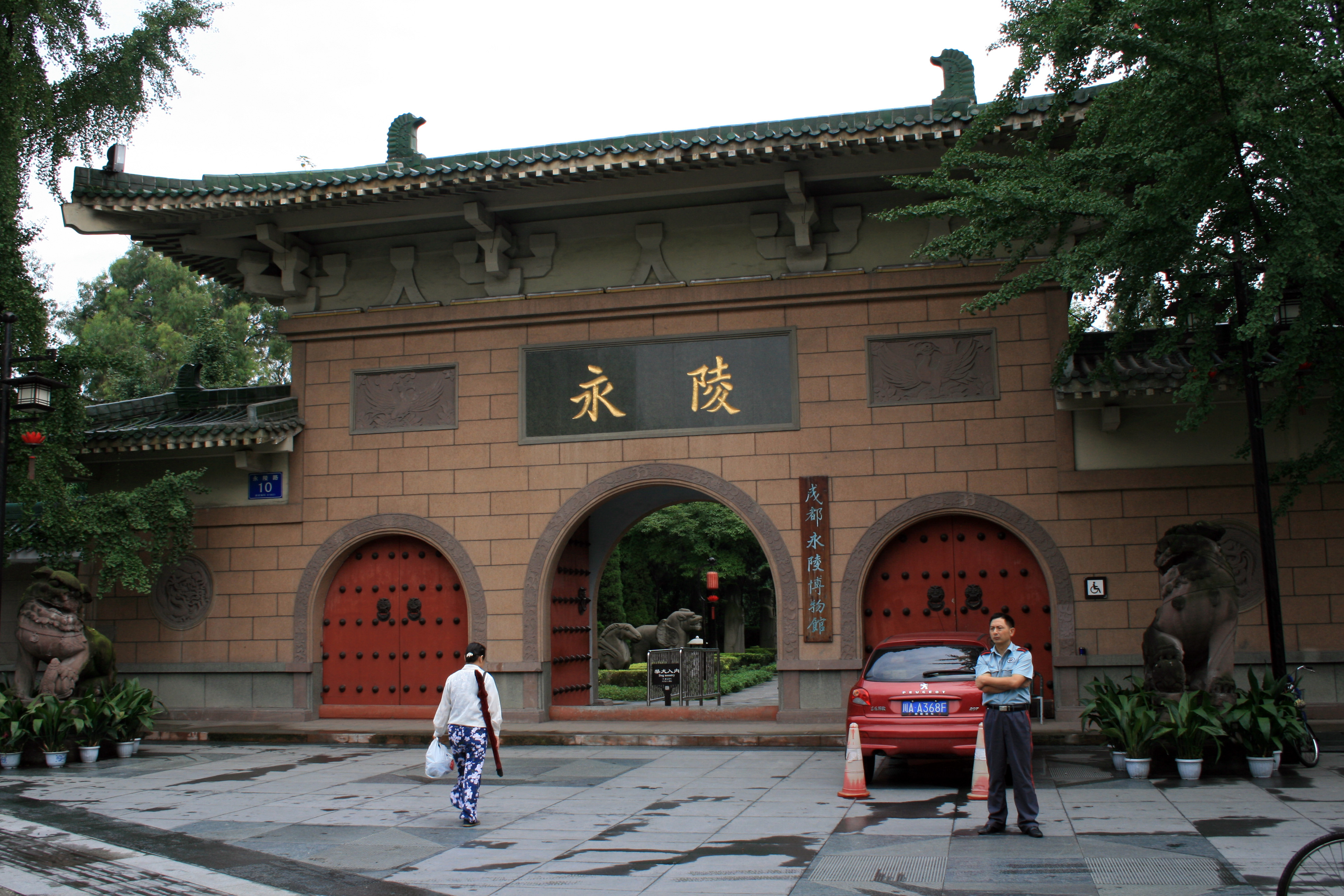|
Empress Gao (Former Shu)
Empress Gao (高皇后, personal name unknown) was an empress of the Chinese Five Dynasties and Ten Kingdoms period state Former Shu. She was the first wife of Former Shu's last emperor Wang Yan (né Wang Zongyan). Background The future Empress Gao's father was the Former Shu official Gao Zhiyan (高知言), who was known for being a minister of defense (兵部尚書, ''Bingbu Shangshu''). She probably married Wang Zongyan while he was crown prince, as her father-in-law, the emperor Wang Jian, created her crown princess.'' Spring and Autumn Annals of the Ten Kingdoms''vol. 38 (As he was created crown prince in 913 and became emperor in 918 upon Wang Jian's death,''Zizhi Tongjian'', vol. 270. the marriage would have been between that period.) As empress Upon Wang Zongyan's assumption of the throne (when he changed his name to Wang Yan), he created Crown Princess Gao empress.''Spring and Autumn Annals of the Ten Kingdoms''vol. 37 However, he did not favor her, particula ... [...More Info...] [...Related Items...] OR: [Wikipedia] [Google] [Baidu] |
History Of China
The earliest known written records of the history of China date from as early as 1250 BC, from the Shang dynasty (c. 1600–1046 BC), during the reign of king Wu Ding. Ancient historical texts such as the '' Book of Documents'' (early chapters, 11th century BC), the '' Bamboo Annals'' (c. 296 BC) and the ''Records of the Grand Historian'' (c. 91 BC) describe a Xia dynasty before the Shang, but no writing is known from the period, and Shang writings do not indicate the existence of the Xia. The Shang ruled in the Yellow River valley, which is commonly held to be the cradle of Chinese civilization. However, Neolithic civilizations originated at various cultural centers along both the Yellow River and Yangtze River. These Yellow River and Yangtze civilizations arose millennia before the Shang. With thousands of years of continuous history, China is among the world's oldest civilizations and is regarded as one of the cradles of civilization. The Zhou dynasty (1046–256 BC) supp ... [...More Info...] [...Related Items...] OR: [Wikipedia] [Google] [Baidu] |
Five Dynasties And Ten Kingdoms Period
The Five Dynasties and Ten Kingdoms period (), from 907 to 979, was an era of political upheaval and division in 10th-century Imperial China. Five dynastic states quickly succeeded one another in the Central Plain, and more than a dozen concurrent dynastic states were established elsewhere, mainly in South China. It was a prolonged period of multiple political divisions in Chinese imperial history. Traditionally, the era is seen as beginning with the fall of the Tang dynasty in 907 and reaching its climax with the founding of the Song dynasty in 960. In the following 19 years, Song gradually subdued the remaining states in South China, but the Liao dynasty still remained in China's north (eventually succeeded by the Jin dynasty), and the Western Xia was eventually established in China's northwest. Many states had been '' de facto'' independent long before 907 as the Tang dynasty's control over its officials waned, but the key event was their recognition as sovereign by ... [...More Info...] [...Related Items...] OR: [Wikipedia] [Google] [Baidu] |
Former Shu
Great Shu (Chinese: 大蜀, Pinyin: Dàshǔ) called in retrospect Former Shu (Chinese: 前蜀, Pinyin: Qiánshǔ) or occasionally Wang Shu (王蜀), was one of the Ten Kingdoms formed during the chaotic period between the rules of the Tang dynasty and the Song dynasty. It existed in 907–925 CE. It was the third state named "Shu" on the same territory, the second one having been Shu Han. The country's name changed from "Shu" to "Han" (Chinese: 漢, Pinyin: Hàn) in 917–918, which is not to be confused with another contemporaneous Chinese kingdom during the same Five Dynasties and Ten Kingdoms period, the Southern Han (), 917–971 CE. Founding of the Former Shu Wang Jian was named military governor of western Sichuan by the Tang court in 891. As the Tang Dynasty weakened and eventually fell in 907, Wang was able to expand his holdings into eastern Sichuan and took the title of emperor as the Tang fell in 907. Geographical extent of the Former Shu The Shu was based in it ... [...More Info...] [...Related Items...] OR: [Wikipedia] [Google] [Baidu] |
Wang Zongyan
Wang Yan (王衍) (899–926), né Wang Zongyan (王宗衍), courtesy name Huayuan (化源), also known as Houzhu (後主, "later Lord"), later posthumously created the Duke of Shunzheng (順正公) by Later Tang, was the second and final emperor of the Chinese Five Dynasties and Ten Kingdoms period state Former Shu. He was the youngest son of Former Shu's first emperor Wang Jian (Emperor Gaozu), but became his heir because his mother Consort Xu was Wang Jian's favorite concubine and was able to gain the support of the chancellor Zhang Ge. Wang Yan's reign was traditionally considered one of decadence, corruption, and incompetence. In 925, his state was conquered by its northeastern neighbor Later Tang. Wang Yan surrendered to the Later Tang army, but was later killed by Emperor Zhuangzong of Later Tang. Background Wang Zongyan was born in 899, during the reign of Emperor Zhaozong of Tang, as the youngest of the 11 sons of Wang Jian, who was then a major warlord late in the T ... [...More Info...] [...Related Items...] OR: [Wikipedia] [Google] [Baidu] |
Crown Prince
A crown prince or hereditary prince is the heir apparent to the throne in a royal or imperial monarchy. The female form of the title is crown princess, which may refer either to an heiress apparent or, especially in earlier times, to the wife of the person styled crown prince. ''Crown prince'' as a descriptive term has been used throughout history for the prince who is first-in-line to a throne and is expected to succeed (i.e. the heir apparent), barring any unforeseen future event preventing this. In certain monarchies, a more specific substantive title A substantive title is a title of nobility or royalty acquired either by individual grant or inheritance. It is to be distinguished from a title shared among cadets, borne as a courtesy title by a peer's relatives, or acquired through marriage. ... may be accorded and become associated with the position of '' heir apparent'' (e.g. Prince of Wales in the United Kingdom or Prince of Asturias in the Spain, Kingdom of Spain) ... [...More Info...] [...Related Items...] OR: [Wikipedia] [Google] [Baidu] |
Wang Jian (Former Shu)
Wang Jian (; 847 – July 11, 918), courtesy name Guangtu (光圖), also known by his temple name as the Emperor Gaozu of Former Shu (前蜀高祖), was the founding emperor of the Former Shu, one of the ten kingdoms during the Five Dynasties and Ten Kingdoms period in Chinese history. He started his career as an army officer under the Tang dynasty eunuch generals Yang Fuguang and Tian Lingzi, eventually seizing control of the modern Sichuan and Chongqing region, founding his state after Tang's destruction. Background Wang Jian was born in 847, during the reign of Emperor Xuānzong of Tang. He was from Wuyang (舞陽, in modern Luohe, Henan), and was said to be ambitious and alert in his youth. However, he was also described to be a hoodlum, abandoning his ancestral craft of baking to be involved in butchering cattle, stealing donkeys, and privateering in salt. His father died while he was still a commoner. At one point, for misdeeds, he was incarcerated at the jail at Xuc ... [...More Info...] [...Related Items...] OR: [Wikipedia] [Google] [Baidu] |
Spring And Autumn Annals Of The Ten Kingdoms
The ''Spring and Autumn Annals of the Ten Kingdoms'', also known by its Chinese title ''Shiguo Chunqiu'' (), is a history of the Ten Kingdoms that existed in southern China after the fall of the Tang Dynasty and before the reunification of China by the Song Dynasty. The book was written and compiled by the Qing Dynasty scholar Wu Renchen ( 1628 – 1689). Wu took part in the compilation of ''Mingshi'', the official history of the Ming Dynasty, and felt that the official dynastic histories have neglected the Ten Kingdoms. The book contains 114 volumes (scrolls). Contents The book consists of 114 volumes covering the histories of the Ten Kingdoms: #14 volumes - Wu (907–937) #20 volumes - Southern Tang (937–975) #13 volumes - Former Shu (907–925) #10 volumes - Later Shu (934–965) #9 volumes - Southern Han (917–971) #10 volumes - Chu (907–951) #13 volumes - Wuyue (907–978) #10 volumes - Min (909–945) #4 volumes - Jingnan (924–963) #5 volumes - Northern Han ... [...More Info...] [...Related Items...] OR: [Wikipedia] [Google] [Baidu] |
Zizhi Tongjian
''Zizhi Tongjian'' () is a pioneering reference work in Chinese historiography, published in 1084 AD during the Northern Song dynasty in the form of a chronicle recording Chinese history from 403 BC to 959 AD, covering 16 dynasties and spanning almost 1400 years. The main text is arranged into 294 scrolls (''juan'' , equivalent to a chapter) totaling about 3 million Chinese characters. In 1065 AD, Emperor Yingzong of Song commissioned his official Sima Guang (1019–1086 AD) to lead a project to compile a universal history of China, and granted him funding and the authority to appoint his own staff. His team took 19 years to complete the work and in 1084 AD it was presented to Emperor Yingzong's successor Emperor Shenzong of Song. It was well-received and has proved to be immensely influential among both scholars and the general public. Endymion Wilkinson regards it as reference quality: "It had an enormous influence on later Chinese historical wri ... [...More Info...] [...Related Items...] OR: [Wikipedia] [Google] [Baidu] |
Empress Zhou (Former Shu)
Empress Zhou (周皇后, personal name unknown) (died October 1, 918Academia Sinica Academia Sinica (AS, la, 1=Academia Sinica, 3=Chinese Academy; ), headquartered in Nangang, Taipei, is the national academy of Taiwan. Founded in Nanking, the academy supports research activities in a wide variety of disciplines, ranging from ...br>Chinese-Western Calendar Converter''Zizhi Tongjian'', :zh:s:資治通鑑/卷270, vol. 270.), formally (as her posthumous name) Empress Shunde (), known as Empress Zhaosheng () in her lifetime, was an empress of the History of China, Chinese Five Dynasties and Ten Kingdoms period state Former Shu, as the wife of Former Shu's first emperor Wang Jian (Former Shu), Wang Jian. Background It is not known when the future Empress Zhou was born, but it is known that her family was from Xu Prefecture (許州, in modern Xuchang, Henan) — the capital of Tang Dynasty's Zhongwu Circuit (), where her husband Wang Jian (Former Shu), Wang Jian started his career ... [...More Info...] [...Related Items...] OR: [Wikipedia] [Google] [Baidu] |





